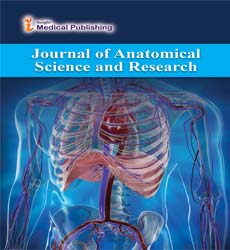Morphological Variations of the Circle of Willis: Implications for Cerebrovascular Disorders
Matthew Collins*
Department of Anatomy and Cell Biology, University of Toronto, Toronto, Canada
*Corresponding Author:
Matthew Collins,
Department of Anatomy and Cell Biology, University of Toronto, Toronto, Canada,
E-mail- matthew.collins@nto.ca
Received date: February 03, 2025; Accepted date: February 05, 2025; Published date: February 28, 2025
Citation: Collins M (2025) Morphological Variations of the Circle of Willis: Implications for Cerebrovascular Disorders. J Anat Sci Res Vol: 8 No: 1: 01
Introduction
The Circle of Willis (CoW) is a critical arterial network located at the base of the brain, forming a vascular ring that ensures collateral circulation between the anterior and posterior cerebral circulations. Its primary function is to maintain adequate cerebral perfusion in the event of vascular occlusion or stenosis. However, anatomical studies have consistently demonstrated that the Circle of Willis exhibits considerable morphological variability, with a complete and symmetrical configuration present in only a minority of individuals. These variations have significant clinical implications, particularly in the context of cerebrovascular disorders such as ischemic stroke, aneurysms, and transient ischemic attacks. The classical Circle of Willis consists of the anterior cerebral arterie, anterior communicating artery, posterior cerebral arteries, and posterior communicating arteries, forming a closed polygonal structure. However, anatomical dissections and angiographic studies reveal that less than 50% of individuals possess a complete and symmetrical CoW. Hypoplasia, agenesis, duplication, or asymmetry of one or more components is commonly reported. These variations compromise the efficiency of collateral flow and predispose individuals to cerebrovascular pathology [1].
Description
One of the most frequent variations involves the anterior communicating artery. Hypoplastic or absent ACoA reduces the ability of the anterior circulation to redistribute blood flow in the event of unilateral internal carotid artery occlusion. Conversely, duplication of the ACoA, though rare, may create hemodynamic turbulence that predisposes to aneurysm formation. Thus, even subtle deviations from the classical pattern may influence disease susceptibility. Posterior circulation variations are also common and clinically relevant. Hypoplasia or absence of the posterior communicating arteries leads to an incomplete posterior part of the CoW, impairing communication between anterior and posterior circulations [2].
Morphological variations are particularly significant in the pathogenesis of intracranial aneurysms. Aneurysms frequently occur at arterial junctions within the CoW, such as the ACoA, PCoA, and bifurcation points. Hemodynamic stress, turbulent flow, and wall shear stress are amplified in anatomically variant configurations, increasing the likelihood of aneurysm formation and rupture. Therefore, knowledge of CoW variations is crucial in assessing aneurysmal risk [3].
In ischemic stroke, the completeness of the Circle of Willis plays a decisive role in determining the extent of collateral circulation. Patients with a well-formed CoW may maintain adequate perfusion despite arterial occlusion, reducing infarct size and improving neurological outcomes. In contrast, those with incomplete configurations are at higher risk of extensive cerebral infarction. This highlights the importance of CoW anatomy in stroke prognosis and therapeutic planning. Neuroimaging modalities such as magnetic resonance angiography, computed tomography angiography, and digital subtraction angiography have greatly facilitated the study of CoW variations in vivo. These techniques provide detailed visualization of vascular morphology, allowing clinicians to evaluate collateral potential in patients with carotid stenosis, aneurysms, or suspected vascular malformations. Preoperative imaging of the CoW is particularly valuable in neurosurgical and endovascular procedures, where an understanding of collateral circulation can guide risk assessment and surgical strategy [4].
Recent research has explored the association between CoW variations and cognitive function. Impaired collateral circulation due to incomplete CoW morphology has been linked to reduced cerebral perfusion and increased vulnerability to chronic ischemic changes, which may contribute to vascular dementia. While the evidence remains preliminary, these findings underscore the broader clinical implications of CoW morphology beyond acute cerebrovascular events. Genetic and developmental factors also influence the formation of the Circle of Willis [5].
Conclusion
The Circle of Willis, though classically depicted as a complete and symmetrical arterial ring, demonstrates considerable morphological variability in the human population. These variations profoundly affect collateral circulation and have significant implications for aneurysm formation, ischemic stroke, and surgical outcomes. Modern imaging and computational approaches have enhanced our ability to assess these variations and their functional consequences. Moving forward, integrating anatomical, hemodynamic, and genetic insights will be crucial for tailoring individualized risk assessments and therapeutic strategies. Ultimately, a deeper understanding of the morphological variations of the Circle of Willis will improve cerebrovascular disease prevention, diagnosis, and management.
Acknowledgement
None.
Conflict of Interest
None.
References
- Yamaguchi R, Otto SP. (2020). Insights from Fisher's geometric model on the likelihood of speciation under different histories of environmental change. Evolution74: 1603-1619.
Google Scholar Cross Ref Indexed at
- Kirschner P, Seifert B, Kröll J, STEPPE Consortium, Schlickâ?Steiner BC, et al. (2023). Phylogenomic inference and demographic model selection suggest peripatric separation of the cryptic steppe ant species Plagiolepis pyrenaica rev. Mol Ecol32: 1149-1168.
Google Scholar Cross Ref Indexed at
- Zander RH. (2024). Lineages of fractal genera comprise the 88-million-year steel evolutionary spine of the ecosphere. Plants13: 1559.
Google Scholar Cross Ref Indexed at
- Gazzarrini E, Cersonsky RK, Bercx M, Adorf CS, Marzari, N. (2024). The rule of four: Anomalous distributions in the stoichiometries of inorganic compounds. Npj Comput. Mater 10: 73.
Google Scholar Cross Ref Indexed at
- Hutchinson J M, Gigerenzer G. (2005). Simple heuristics and rules of thumb: Where psychologists and behavioural biologists might meet. Behav Process69: 97-124.
Open Access Journals
- Aquaculture & Veterinary Science
- Chemistry & Chemical Sciences
- Clinical Sciences
- Engineering
- General Science
- Genetics & Molecular Biology
- Health Care & Nursing
- Immunology & Microbiology
- Materials Science
- Mathematics & Physics
- Medical Sciences
- Neurology & Psychiatry
- Oncology & Cancer Science
- Pharmaceutical Sciences
